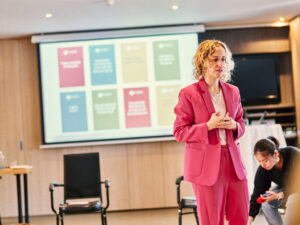At Beanmachine, our mission is to foster authentic, resilient, and empathetic leadership. Recently, an article from Harvard Business Review by Mita Mallick titled “Does Your Boss Practice Toxic Positivity?” caught our attention, as it delves into a critical issue that many of our clients face. The phenomenon of toxic positivity in leadership is more prevalent than one might think, and understanding its nuances can help organizations create a healthier work environment.
The problem with toxic positivity
While a positive attitude at work can significantly boost employee productivity and creativity, there is a dark side to unrelenting positivity. According to research by Saïd Business School and insights from Shawn Achor, author of The Happiness Advantage, positivity, when grounded in reality, can lead to enhanced performance and well-being. However, when leaders practice toxic positivity, they ignore real challenges and place undue pressure on employees to maintain a facade of happiness, regardless of the circumstances.
Real-world impacts and red flags
Toxic positivity in leadership can manifest in various ways, often causing more harm than good. Here are some red flags to watch for:
-
- Surrounding themselves with yes-people: Leaders who refuse to accept “no” for an answer and surround themselves with individuals who don’t challenge their directives can create an environment of chronic overpromising and underdelivering.
-
- Excessive praise as manipulation: Using flattery to motivate employees into taking on impossible tasks can lead to burnout and diminished morale, especially during periods of layoffs and budget cuts
-
- Expecting perpetual happiness: Leaders who demand constant positivity from their teams, dismissing any signs of stress or dissatisfaction, can cause significant emotional strain.
Recognizing toxic positivity
Here are some tips to help you recognize toxic positivity in the workplace:
-
- Unrealistic optimism: If your leader consistently downplays challenges and insists that everything is possible without addressing real obstacles, this is a sign of toxic positivity.
-
- Dismissal of negative emotions: Leaders who frequently use phrases like ‘Look at the bright side’ or ‘It could be worse’ may be invalidating genuine concerns and emotions
- Pressure to be happy: If there is an expectation to always appear happy and positive, even in difficult circumstances, this can lead to burnout and a lack of authentic communication
Strategies for well-balanced leadership
Balancing optimism with realism is crucial for effective leadership. Here are some strategies to foster a healthier work environment:
-
- Encourage open communication: Regularly check in with your team to understand their concerns and create a culture where employees feel safe te express their concerns and challenges without fear of retribution, cfr. ‘psychological safety‘.
-
- Acknowledge and address obstacles: Be transparant about the difficulties the team faces and work collaboratively to find solutions. This shift not only improves morale but also enhances problem-solving capabilities within the team.
-
- Balance praise with constructive feedback: While it is important to recognize and celebrate successes, also provide constructive feedback. Help employees understand areas for improvement and support their development.
-
- Provide genuine support: Offer practical help and empathy rather than superficial positivity. Ask team members how you can support them and take actionable steps to assist. This might include reallocating resources, adjusting deadlines, or providing additional training.
-
- Encourage work-life balance: Recognize the importance of personal well-being. Encourage employees to take breaks, set boundaries, and prioritize their health to prevent burnout.
Conclusion
At Beanmachine, we advocate for leadership that is both optimistic and grounded in reality. By recognizing the signs of toxic positivity and fostering a culture of genuine support and open communication, organizations can create healthier, more productive work environments.





